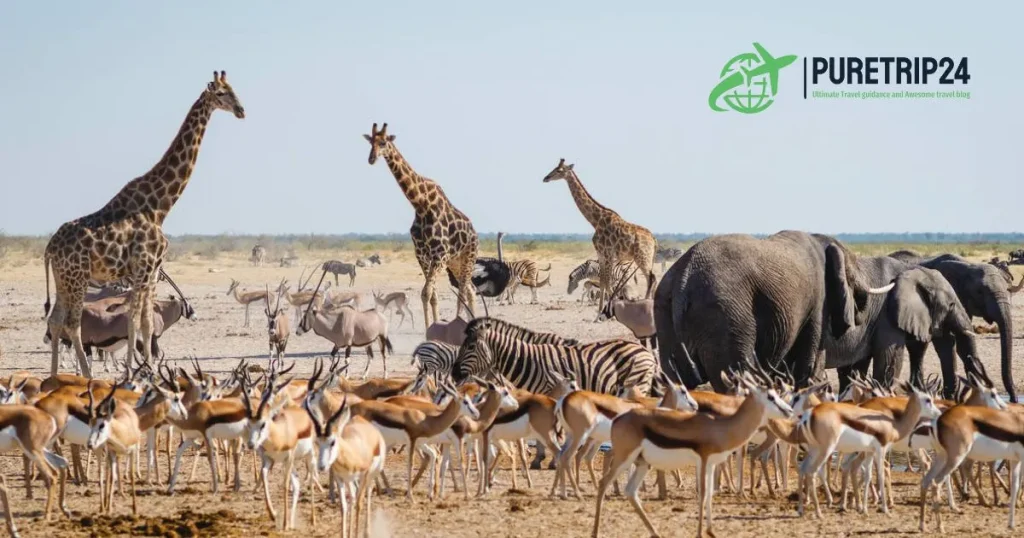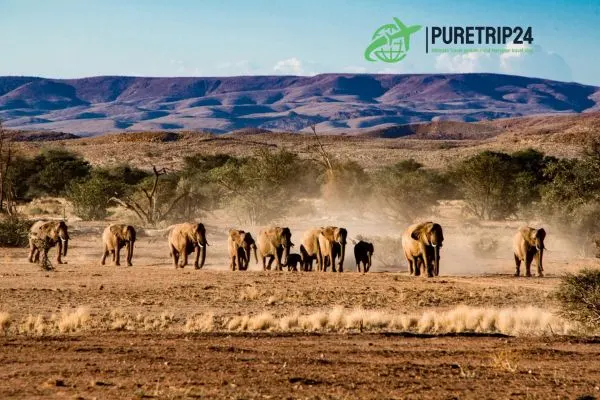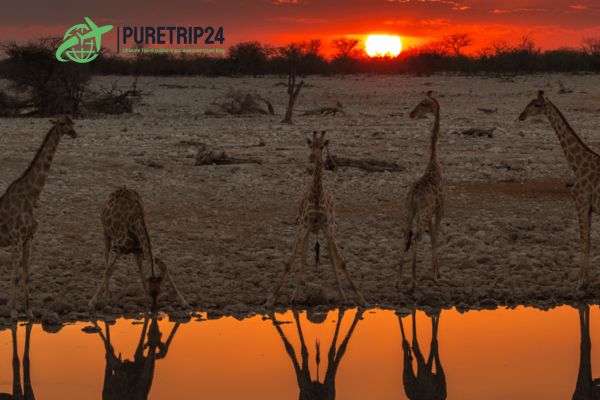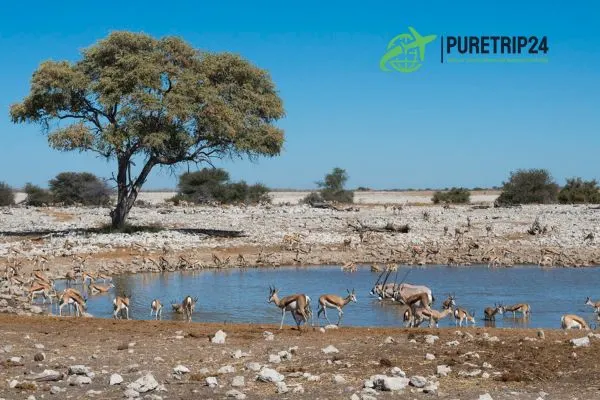Located in northern Namibia, Etosha National Park is one of Africa’s top wildlife-watching venues. Renowned for its enormous salt pan, varied habitats, and big game viewing opportunities Etosha is perfect if you are a traveler looking to get back into nature. In this detailed guide, we will discover everything about Etosha National Park — when you should visit it, what to see in the park including types of accommodation and important information for a successful journey.

Etosha National Park – Why Visit?
Unique Ecosystem
Namibia national parks– covers an area of 22,000 sq km changing landscapes from savannah to grassland through woodland ending in wetlands. Central to the park is the Etosha Pan, a flat dried salt bed that appears as one enormous hyper-real white desert in the dry season. Home to a variety of wildlife with more notable resident species — including elephants, lions, giraffes, and zebras making for excellent photographic images along the meandering rivers baobabs), in addition to well over 340 bird species.
WildlifeViewing
One of Etosha’s best claims to fame is its spotting potential. Game viewing: Water is a major attraction all year round and the park’s waterholes provide excellent opportunities to view games. Large herds of elephants, the ever-elusive and majestic big cats are often sighted on the prowl. Relaxing in their natural habitat. Early mornings and late afternoons are the best times to capture amazing photographs of wildlife since photos taken during these magic hours register beautiful colors only present in those natural sunrises or golden hour.
Best Time to Visit

Dry Season (May to October)
The dry season is one of the best times to go if you can, while others believe it’s always a good time. In addition, as water sources become scarce, animals flock to the few remaining watering spots which make sightings easier and more predictable. During the day temperatures are nice, but it can get very cold at night so be sure to pack accordingly.
The wets (Nov — April)
Although the wet season can be decidedly less ideal for game viewing, it does provide some unique and undeniably charming opportunities on safari. This is when the migration of birds takes place and everything turns green. But rain could leave some roads closed. The rainy season will appeal to you if enjoy rates and birdwatching, or see the just-born offspring.
Getting There

By Air
The next closest airport to Etosha National Park is in Windhoek, the capital of Namibia. A domestic flight from Windhoek to one of the surrounding bush airstrips or a hired car operate out as possibilities. Grid — A road trip through Namibia to take In the fantastic landscapes of this African country on your way.
By Road
The most popular form of getting around in Etosha is by car. It is a 2WD drive park accessible via sealed roads and also makes for an easy day trip from Sydney. Choosing a self-drive allows you the freedom to explore at your own pace and stop for photography or wildlife sightings whenever desired.
Accommodations
Inside the Park
From simple campsites to luxury lodges, there is accommodation for everyone in Etosha National Park. While chilling inside the park is perfect if you want to be near a waterhole for game viewing. Popular camps include:
Okaukuejo Camp: Home to a floodlit waterhole that allows for wildlife sightings at night
Halali Camp:It is located between two waterholes hence being an ideal place for child-friendly tents.
Namutoni Camp:A historic fortress-like structure close to the park’s eastern edge.
Outside the Park
Those seeking a bit more creature comfort, or an individual experience can take up lodges and guesthouses (but still based at the edge of the park). These usually include a guided itinerary and extra add-ons for cultural experiences with the community.
What to See and Do
Game Drives
Then go out on game drives with a guide or self-drived to explore the park. The evening/early morning drives are the most successful for wildlife spotting. Look out for the “Big Five” (elephants, lions, leopards, rhinos,s and buffalo) as well as countless other species.
Birdwatching
Etosha has over 340 recorded bird species, offering a mecca to ornithologists. The wet season is for birds that migrate here while the driest season allows visitors to spot species like African fish eagles, ostriches, and secretary birds.
Cultural Experiences
Get involved with the nearby Etosha surrounding communities — see how natively amongst the colorful Himba and Ovambo cultures. There are also guided trips to enjoy the traditional dances, handicrafts, or local food served in some lodges or etosha national park animals.
Etosha National Park Travel Tips At Puretrip24

Stay Hydrated
During the dry season, is SO hot in Namibia Make sure to take lots of water, sunscreen,n and a sunhat with you.
Respect Wildlife
Always keep a good distance from wild animals and do not feed or try to harm them. Honor park RULES AND recommendations FOR A secure and powerful BEING within the WİLD PLUS CHECK OUT safety OF ANIMAL IDENTIFICATION — BE bear AWARDS throughout Tanzania remains to be tremendously exact.
Plan Ahead
Remember, park lodging goes fast, especially in the heart of summer. Register ahead of time to get the lodging you desire.
Conclusion
For all wildlife and nature lovers, Etosha National Park is a must-see destination on every Namibia travel itinerary. At Etosha, you can expect to have an unforgettable experience, I loved how beautiful the wildlife blends well with the natural landscape. If you decide to embark on a self-drive expedition or participate in guided tours within the park, its stunning beauty and variety will astound you. Plan your trip to Etosha National Park now and have an adventure of a lifetime!
Make sure to maximize what you get out of your trip by adjusting for economy, comfort, ease, and especially; pleasure in visiting this awesome Namibian Gem. For more travel & trip info check puretrip24.com
